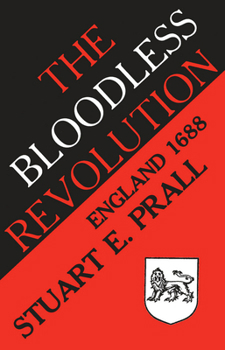The Bloodless Revolution: England, 1688
The Glorious Revolution of 1688 represented a crucial turning point in modern British history by decisively shifting political power from the monarchy to Parliament. In this cogent study, first published in 1972, Stuart Prall offers a well-balanced account of the Revolution, its roots, and its consequences. The events of 1688, Prall argues, cannot be viewed in isolation. Examining the tempestuous half-century that preceded and precipitated William...
Format:Paperback
Language:English
ISBN:0299102947
ISBN13:9780299102944
Release Date:November 1985
Publisher:University of Wisconsin Press
Length:360 Pages
Weight:0.65 lbs.
Dimensions:0.9" x 4.5" x 7.0"
Customer Reviews
2 ratings
extensive and non-biased study
Published by Thriftbooks.com User , 20 years ago
Stuart E. Prall's "The Bloodless Revolution" is an extensive and non-biased study of the seminal constitutional developments in 17th century England; which defined the constitutional monarchy in Britain in the age when absolutism reigned supreme elsewhere in the world. Author prepares the scene for the revolution by explaining relationship between king and the Parliament throughout Stuart dynasty starting from James I, thought Long Parliament, Civil War, Protectorate, Restoration, last years of Charles II, and the many encroachment on liberties and mistakes of James II which ultimately led to Glorious Revolution. Emphasis is on developments in the legal system and relationship between multiple religious institutions and political parties during and after the Restoration period.One extended quote from the book might give you a flavor of the level of scholarship and insights this book will offer. "The medieval and Tudor view of the dispensing power was premised on the distinction between malum prohibitum (a prohibited evil) and malum per se (an evil in itself). The distinction was essentially medieval, and the foundation was divine law and/or natural law. Restrictions considered man-made (malum prohibitum) could be dispensed with. Restrictions that were thought to have been authored by God or Nature (malum per se) were not to be dispensed with. These distinctions permeated both the secular and the ecclesiastical structures of the medieval worlds. The Tudor era, especially after the English Reformation, saw the gradual secularization of the political and legal thought and the gradual erosion of the distinction , because the whole conception of divine and natural law was one of the victims of the new age of science and its concomitant mechanical laws of nature, which were coming to the fore in the seventeenth century. One result of the pre-1640 struggle for sovereignty and the constitutional struggle of the Puritan Revolution itself has bee the triumph of the principle that sovereign power was identical with the lawmaking, or legislative, power. Neither the Long Parliament or Protectorate felt any divine or natural limitation upon their ultimate freedom to exercise total legislative authority. The lesson of the Restoration had been that the supreme or sovereign legislative authority did exist in the English state, and that it existed in the triple-headed institution of the King-in-Parliament. The problem was very complex. Because if the king-in-Parliament can make or unmake any and all laws, then there is no longer any practical distinction between the malum prohibitum and malum per se. All laws are merely malum prohibitum. The state is supreme, not God or Nature. The result is that the king could now feel free, at least in theory, to dispense with any law, while those who might oppose his particular use of this power ... would be thrown back upon the old medieval distinction between the human and the divine. English constitutional development was
the finest book on the subject
Published by Thriftbooks.com User , 26 years ago
This is a stupendous book. It reveals the Glorious Revolution in its entirety. From the Restoration to the Act of Settlement, nothing is overlooked. In addition, the book is written without any of the historical or idealogical predispositions which have long plagued previous studies of this seminal revolution.





